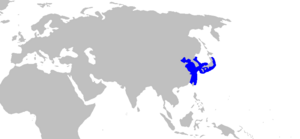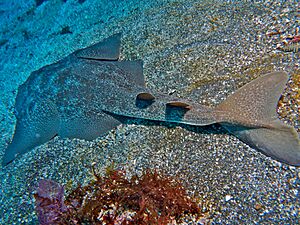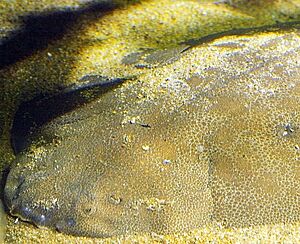Japanese angelshark facts for kids
Quick facts for kids Japanese angelshark |
|
|---|---|
 |
|
| Conservation status | |
| Scientific classification | |
| Genus: |
Squatina
|
| Species: |
japonica
|
 |
|
| Range of the Japanese angelshark | |
The Japanese angelshark (Squatina japonica) is a special type of shark that looks very flat, almost like a ray. It belongs to the family called Squatinidae, which are known as angelsharks. You can find this shark in the northwestern Pacific Ocean, near countries like China, Japan, and Korea.
This shark lives on the bottom of the ocean, usually in sandy areas, and can be found as deep as 300 meters (about 980 feet). Like other angelsharks, it has a flat body with wide, wing-like pectoral and pelvic fins. It can grow to be 1.5 meters (about 5 feet) or even longer. It has two dorsal fins located behind its pelvic fins, and a line of large thorns runs down its back. Its top side is covered in a pattern of dark, square-shaped spots on a brown background, which helps it camouflage itself.
The Japanese angelshark is a nocturnal hunter, meaning it hunts at night. It's an ambush predator, so it waits quietly for its prey. It mostly eats fishes, cephalopods (like squid and octopus), and crustaceans (like crabs and shrimp). This shark gives birth to live young, which grow inside the mother and get their food from a yolk sac. A mother can have anywhere from two to 10 babies at a time. The Japanese angelshark is not dangerous to people unless it feels threatened. People often catch these sharks for their meat and for their tough skin, which is used to make a type of leather called shagreen.
Contents
About the Japanese Angelshark
The Japanese angelshark was first described by a Dutch scientist named Pieter Bleeker in 1858. He was an ichthyologist, which means he studied fish. The first shark he studied for this description was a male, 53 centimeters (about 21 inches) long, found near Nagasaki, Japan. This is why its scientific name includes japonica. People also call this shark by other names, like the Japanese angelfish or Japanese monkfish.
Scientists have studied the DNA of the Japanese angelshark to understand how it's related to other sharks. They found that it's closely related to other angelsharks found in Asia, like the ocellated angelshark and the Taiwan angelshark. These Asian angelsharks are also related to angelshark species found in Europe and North Africa. Scientists believe that the Japanese angelshark's ancestors separated from other Asian angelsharks about 100 million years ago.
What it Looks Like
The Japanese angelshark has a body that is not very wide, but its pectoral and pelvic fins are very large. The skin on the sides of its head is smooth and doesn't have any special flaps. Its eyes are oval-shaped and set far apart. Just behind its eyes are two crescent-shaped openings called spiracles, which have large bumps inside them.
Each nostril is big and has a small skin flap in front of it with two small whiskers, called barbels. The outer barbel is thin, while the inner one looks like a spoon. The shark's mouth is wide and at the very front of its head, with grooves at the corners. It has 10 rows of small, narrow, pointed teeth on each side of both its upper and lower jaws, with a space in the middle. It also has five pairs of gill slits on the sides of its head.
The front part of each pectoral fin forms a triangle shape that is separate from the head. The outer edges of these fins are sharp, and their back tips are rounded. The pelvic fins have curved edges. The two dorsal fins are similar in shape and size, and they are located behind the pelvic fins. The tail area is flat and has a ridge along each side. The tail fin is roughly triangular with rounded corners, and its lower part is bigger than the upper part.
The top of the shark's body is covered in medium-sized, rough scales called dermal denticles. A special line of large thorns runs down the middle of its back and tail. The shark's color ranges from light to dark brown on top, with many dark, square-shaped spots. These spots become smaller on its fins. Its underside is white with darker blotches. Different reports say this shark can grow to be between 1.5 meters (5 feet) and 2.5 meters (8.2 feet) long.
Where it Lives and Its Home
The Japanese angelshark lives in the colder waters of the northwestern Pacific Ocean. Its home stretches from the eastern coast of Honshu, Japan, all the way to Taiwan. This includes the southern Sea of Japan, the Yellow Sea, the East China Sea, and the Taiwan Strait. Some older reports suggested it might live in the Philippines, but newer studies show a different angelshark species lives there.
This shark lives on the continental shelf, which is the shallow part of the ocean floor that extends from a continent. It usually stays in shallow waters, but it can also be found as deep as 300 meters (about 980 feet). It is a bottom-dweller, meaning it lives on the seabed, usually over sandy areas, often near rocky reefs.
Life and Habits
During the day, the Japanese angelshark usually lies partly buried in the sand on the ocean floor. Its complex color pattern helps it blend in perfectly with its surroundings, making it hard for prey to see. This allows it to ambush any fish or other animals that swim too close. At night, this shark becomes more active and moves around to hunt.
Its diet includes demersal fishes (fish that live near the bottom), cephalopods like squid, and crustaceans like crabs and shrimp. You might find these sharks alone or sometimes close to other Japanese angelsharks.
Reproduction
The Japanese angelshark is viviparous, which means it gives birth to live young, just like mammals. The baby sharks grow inside the mother, and they get all their food from a yolk sac, similar to a chicken egg. Mothers usually give birth to two to ten pups (baby sharks) during the spring and summer months. When they are born, the newborns are about 22 centimeters (about 8.7 inches) long. Female sharks are ready to have babies when they are about 80 centimeters (about 31 inches) long. Scientists don't yet know the exact size when male sharks become mature.
Humans and the Japanese Angelshark
The Japanese angelshark is usually not aggressive towards humans. However, if it feels threatened or is bothered, it can bite, and its bite can be quite painful. In many parts of its home range, this shark is often caught by accident in large fishing nets, especially those used for bottom trawling, which drag along the ocean floor. It's also caught in set nets and demersal gillnets.
When caught, the shark's meat is eaten. Its rough skin is also used to make shagreen, a type of leather that is sometimes used in wood finishing or for decorative items.
Angelsharks in general are very vulnerable to commercial fishing, especially trawling. This is because they are easily caught in nets, and they don't reproduce very quickly. Other types of angelsharks have seen their numbers drop a lot because of fishing. Fishing activity in the Yellow Sea and other parts of the northwestern Pacific is very intense. This, along with pollution, has seriously harmed the local ocean ecosystem. Scientists believe the number of Japanese angelsharks has gone down by 50% or even more because of these problems.
Because of this, the International Union for Conservation of Nature (IUCN) has listed the Japanese angelshark as critically endangered. This means it faces a very high risk of becoming extinct in the wild. There's some hope that a ban on trawling in certain areas by the Chinese government might help the species, but these rules are not always followed strictly.




